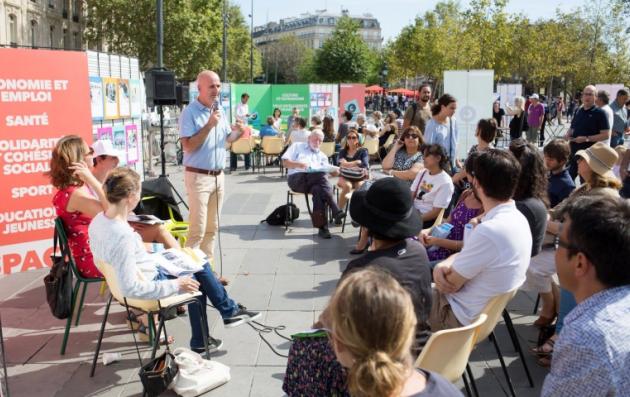Summary
In late 2014, Paris (FR) Mayor Anne Hidalgo set out to deliver on her ambition to turn the city into a more collaborative one, where residents play an active role in the ideas and decisions which shape its future.
The first step was to introduce a participatory budgeting programme. In 2014, over 40,000 people voted on 15 proposals put forward by the City Council. In the second year, the residents of Paris suggested over 5,000 ideas and more than 67,000 people voted. In 2016, the City has decided to reserve a proportion exclusively for the most deprived areas of the city.
Another proportion was reserved for spending on youth and education projects, with schools being encouraged to participate and children's votes determining how that money is spent. Those children in turn may have educated and encouraged their families to take part. In October 2016, over 158,000 people voted in the latest round, a 39% increase on 2015, deciding how to spend 100 million euros.
The solutions offered by the good practice
The Participatory Budget asks people to come up with solutions to problems in their community, on which they are the experts and in which they are highly invested. The nature of the process gives ample opportunity for the plurality of voices to be heard, while also encouraging collaboration and consensus building among participants with similar agendas, and finally giving everyone the opportunity to vote for those ideas which matter most to them.
5% of the capital budget of the city is dedicated to participatory budgeting. Thus the practice means transferring to citizens the design and selection of projects representing a public investment of 100 million euros a year.
Projects submitted by citizens have to be feasible and have to meet three criteria: they have to be about capital, have to be related to cities’ competencies and they have to fall under general interest.
In Paris, we have 21 PBs: 1 PB per district for local projects, 1 PB for the entire city for major or replicable projects, one PB for schools and one for social housing.
Lastly, the Paris Participatory Budget is a year-long process with four main steps. Firstly we stimulate ideas and projects and collect them on our digital platform. Secondly civil servants study the feasibility and evaluate the cost for each project. If a project is not feasible, the sponsor of the project receives a personal answer visible on the online platform. The third stage is the campaign and the vote. Finally the city implements the selected projects.
Building on the sustainable and integrated approach
The Paris Participatory Budget contributes to sustainable urban living since it is a major call from inhabitants. This learning is clear when observing the projects they submit and the ones they choose during the vote.
As an example, there were eight winning projects on the Parisian scale in 2015: one project devoted to bicycle lane development (8 million euros), one project targeting a pedestrian friendly city (8 million euros), one project focusing on the reinvestment of our green belt (old railway line) for 7.5 million euros, one project that aims at fighting poverty (4.4 million euros), two projects on green spaces, including rooftops and urban agriculture (4.3 million euros), one project to develop drinking water fountains in Paris (2 million euros) and a 1 million euro project dedicated to cleaning improvement of the city.
Based on a participatory approach
The Paris Participatory Budget is based on an integrated and participative approach: the policy is inherently participative and coordinated by the head of the City. It involves all departments in feasibility studies and implementation. Innovative digital tools have been developed to support cross-sectoral cooperation and a dedicated team is facilitating these cooperative ways of working.
Also it is based on cooperation between districts and central city offices as a way to articulate global and local scales.
What difference has it made?
In the initial 2014 pilot over 41,000 votes were cast in total. Nine projects were selected. The 2015 iteration represented a significant expansion of the initiative. Over 5,000 ideas were proposed, of which 3,000 passed the initial basic criteria. In the final stage 67,000 votes (+/- 3 per cent of the population) were cast and 188 projects accepted. In 2016, participation rose with 158,964 people voting on a final selection of 219 ideas, from an initial 3,158 proposals. The number of participants was boosted by just over 66,000 children who took part in a special ballot to allocate €10 million reserved for projects in schools and colleges.
Budgeting process is also delivering tangible outcomes: more than a quarter of 416 winning projects have been delivered such as new public gardens, co-working spaces, renovated schools, pedestrian areas, sport facilities, etc. This has brought new ways of working inside the city’s offices based on more cooperation and new kind of relationship between civil servants and citizens.
Finally, the Participatory Budget is also a support for public innovation: the project named “shelters for homeless” has received 21000 votes in 2016, which is the highest number of votes among projects. It is a call for the City to find innovative ways to fight poverty and welcome migrants.
Why should other European cities use it?
We are regularly invited to present Participatory Budget by other cities: since December 2016, we have been travelling to conferences hosted by the cities of Kyoto and Mexico. Delegates from Glasgow and Tallinn came to Paris and we were invited to go to Edinburgh to present our findings to parliamentarians and local authorities.
Also, Paris has been awarded Pilot City by the Open Government Platform last December, as a result of its participatory budget. We see these many invitations to present what we have learned, factors for success and ongoing challenges. We believe it shows other European (and worldwide) cities’ willingness to implement their own Participatory Budget.
-
490_Paris_GPsummary.pdf(PDF, 203Ko)

